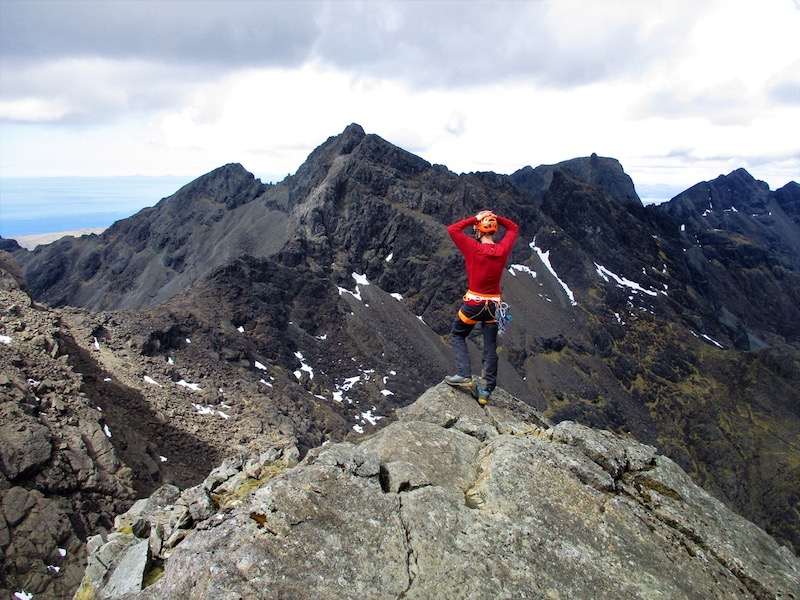Scrambling opens up a whole new world of adventure in the mountains, giving you access to beautifully rugged vistas, but you need to know what you’re doing. Here, David Buckett explains how you can get into it.
Scrambling is one of the most interesting ways to get up high in the hills. It fully occupies the mind, the rock adds an extra dimension of interest and you get into some strange and wonderful places. If you pick the correct route for the conditions and your ability it can be highly rewarding, as it will allow you to get away from the crowds and see the more hidden side of our mountains.
Your First Scramble
I have had many situations where my stomach has tried to make a quick exit from my body when I have been scrambling. So if it’s your first time getting on a scramble you have a few options to help create an experience you will remember for all the right reasons. You could go with more experienced friends, pick a route that has easy exits/bypass routes, or get some professional instruction and use the experience and knowledge to boost your confidence with the instructor’s support.
Understanding the Grades
Grade 1: Expect short small steps; you may need to use a hand for balance on a few moves and ridges usually are not too narrow or have escape routes. Example: The Ledge Route, Ben Nevis.
Grade 2: Expect longer rocky sections (in ascent or descent), and the need to use hands to link a few ‘climbing moves’. Ridges can be exposed. Example: The Aonach Eagach Ridge, Glen Coe.
Grade 3: This means continuous use of hands for long rock sections in ascent or descent, plus exposure and high consequence. Example: Sgurr nan Gillean, south east ridge, on the Isle of Skye.
Likelihood vs consequence
You need to accept that when you are scrambling you are taking an additional risk of a slip compared to ordinary walking. Here is a way to look at a situation objectively.
Rank the likelihood of a slip from one to three and the severity of the consequence from one to three. For example, on a very hard move, you may slip off (3), but there’s a big grassy ledge to land on, while the step is not high off the ground (1). Alternatively, you may be tackling a very easy step that you could do with your hands in your pockets (1), but conditions may be wet and windy, and a small drop off the step could see you tumble onto a long scree slope (3). If you get a score of five in total, you need to revise the situation. This might involve changing what you do, slightly altering the route, having a spotter or accepting it’s not the right conditions.
Balance is Key
Having good footwork and balance is key. Be precise with your boots. I think of placing my big toe when using foot holds. Take small vertical steps rather than big single hoicks. Keep your centre of gravity above your feet and within your arms; think of making a square with your hands and feet, keeping your torso within that square. Go slow when it’s hard!
Stop, Reverse!
Can you go down what you have gone up? This is a separate skill and could get you out of a tricky situation if the route above is wet and slimy or you don’t like the look of it. Down climbing is important to practise, and you can either face into or outwards from the rock.
Weather and Environment
Small plants help keep rocks where they are, so please tread lightly and hold the rocks rather than the plant life. Weather has a massive effect on scrambling, as wind and wet rock can change everything, including the likelihood vs consequence equation.
To Rope or Not to Rope
If you need the support of a rope, make sure your partner knows how to keep you safe. If not, it’s better to drop a grade and get more mileage, therefore becoming more experienced and confident. Using a rope with natural anchors looks simple, but there is a lot of judgement going on and it is best to get a professional mountaineering instructor to ‘show you the ropes’
Who’s writing?
David Buckett is a professional Mountaineering Instructor for Thistle Trekking. Based in Fort William he can be found scrambling on Ben Nevis, Glen Coe and Skye, delivering mountaineering courses and guided adventures. He has several trips to the Alps under his belt, as well as Nepal and India. He has also guided botanists and geologists surveying the entire north face of Ben Nevis looking for rare alpine plants and new theories to the formation of Ben Nevis. You can join Dave on Thistle Trekking’s Skye Munros Scrambling course this summer.



